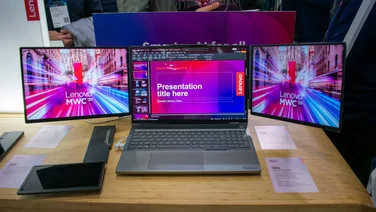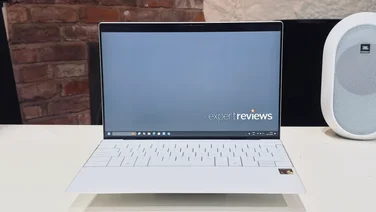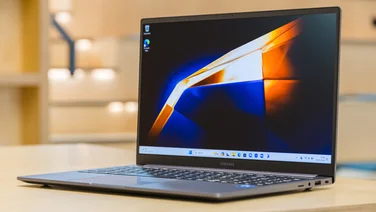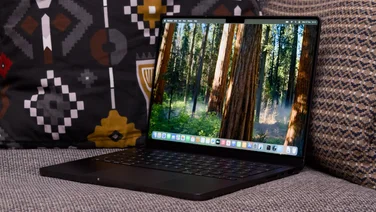To help us provide you with free impartial advice, we may earn a commission if you buy through links on our site. Learn more
- Apple MacBook Pro 16in review: What you need to know
- Apple MacBook Pro 16in (2021, M1 Pro) review: Price and competition
- Apple MacBook Pro 16in (2021) review: Design and key features
- Apple MacBook Pro 16in (2021, M1 Pro) review: Display
- Apple MacBook Pro 16in (2021, M1 Pro) review: Performance
- Apple MacBook Pro review: Verdict











- Superb mini-LED screen
- Incredibly powerful
- Great battery life
- A touch heavy
With the launch of the MacBook Pro 16in (2021) and 14in last month, Apple’s escape from the clutches of Intel is nearly complete. The only device in the range that remains to make the transition is the iMac Pro but it can’t be long before that makes the jump, too.
For now, however, Mac power junkies will have to satisfy themselves with the redesigned 14in and 16in MacBook Pro machines. Not that I can imagine anyone being dissatisfied with either one.
Thanks to the new Apple M1 Pro and Pro Max processors, sumptuous mini-LED displays and an expanded array of physical ports, among many other things, Apple’s new machines should be the laptops of choice for the demanding mobile professional for the foreseeable future.
READ NEXT: Our guide to the best laptops you can buy
Apple MacBook Pro 16in review: What you need to know
This review will focus on the 16in MacBook Pro, which was the model Apple sent to me for review. It sits right at the top of the MacBook Pro scale, comes with a 16.2in display and the option of the M1 Pro processor (with ten CPU cores and ten GPU cores), or the M1 Max, which comes with ten CPU cores and 24 or 32 GPU cores.
These are backed by a choice of 16GB or 32GB of RAM (64GB is also available but only with the M1 Max) and SSD storage options ranging from 512GB right up to 8TB. The 16in MacBook Pro is a real workhorse, perfect for demanding jobs such as 4K or 8K video editing, 3D rendering and intensive software development.
It’s not all about the new M1 processors, however. The new Liquid Retina XDR display deserves plenty of headlines in its own right. It employs a mini-LED panel just like the one in the M1 iPad Pro 12.9 but with even higher specifications: peak brightness reaches a quoted 1,600cd/m2 and it comes with Apple’s 120Hz ProMotion technology as well.











Other new features include the return of a number of much-missed features. MagSafe is back, there’s now a full-height function key row, and the MacBook Pro 16in also comes with a selection of pro-focussed physical ports, including a full-sized HDMI output and – YES! AT LONG LAST – a full-sized SD card slot.
That’s not to mention a huge 100Wh battery that Apple promises will deliver up to 21 hours of video playback and 14 hours of wireless web browsing on the 16in MacBook Pro, plus an improved keyboard and FaceTime HD webcam.
READ NEXT: Huawei MateBook 14s review
Apple MacBook Pro 16in (2021, M1 Pro) review: Price and competition
As ever, you can choose between a number of different configurations with the 2021 MacBook Pro 16in, with prices ranging from £2,399 (M1 Pro, 16GB RAM, 512GB SSD) all the way up to £5,899 (M1 Max, 64GB RAM, 8TB SSD).
Much though we’d have loved Apple to send us the top-end model, the model on test is more representative of the sort of specification most people will opt for, with an M1 Pro processor supplemented by 32GB of RAM and a 1TB SSD.
If your budget can’t stretch to the 16in MacBook Pro, the 14in model starts at £1,899 (M1 Pro, 16GB RAM, 512GB SSD) and delivers similar levels of performance. Note, though, that the base model comes with a version of the M1 Pro with only eight CPU cores, instead of ten.
Next up, there’s the less powerful MacBook Pro 13in, which begins at £1,299 (M1, 8GB RAM, 256GB SSD) and the MacBook Air starts at £999 (M1, 8GB RAM, 256GB SSD). Both are highly capable machines, too.
If I’m going to be completely honest, there aren’t any Windows laptops we’ve reviewed recently that can match the MacBook Pro 16in’s combination of portability, power and battery life. The closest in terms of raw power is the Alienware x15 R1, which gets you a laptop that delivers similar levels of power, better gaming performance, but far shorter battery life and a less impressive display.
If you don’t mind missing out on the sheer power of the MacBook, we’re also big fans of the Asus ROG Zephyrus M16 G603. For £2,299 you can buy one with an Intel Core i9-11900H CPU, 32GB of RAM, an Nvidia GeForce RTX 3070 GPU and a huge 2TB SSD.
It’s lightweight and slim and the RTX 3070 GPU makes it a fabulous portable gaming machine; again, however, the battery life and display still can’t match what’s on offer on the Apple MacBook Pro 16in.
READ NEXT: Our guide to the best laptops you can buy











Apple MacBook Pro 16in (2021) review: Design and key features
The design of the MacBook Pro laptops has followed a familiar template for a few years now so the 2021’s models come as quite the breath of fresh air, with a flatter, less rounded profile to the lid and fewer sharp edges at the periphery of the laptop.
Not that this represents a particularly bold style statement. Notwithstanding the bombproof build – and accompanying 1.6kg heft – the new MacBook Pro is still a fairly bland chunk of aluminium with the Apple logo stamped into the lid, a large glass trackpad and not many other physical features to take note of.
Those in the know, however, will spot a few key differences on closer inspection. There are more ports for starters and it’s great to see the return of the MagSafe power connector. No longer do you have to fear for the safety of your £2,399 laptop when you plug it into a nearby wall socket – and tripping over the cable is far less likely to damage the circuitry behind the socket than if the same thing were to happen with the previous USB-C connector. You can still charge the MacBook Pro 16in via USB-C if you forget your MagSafe charger, too.











Professional and keen amateur photographers will rejoice at the reappearance of a full-sized SD card slot, too, and it’s also great to welcome back a full-sized HDMI output, although it’s only version 2.0 rather than 2.1. Add three Thunderbolt 4 ports and a 3.5mm headset jack and you may well be able to ditch your USB-C dock and bundle of adapters altogether.
Open the lid and more differences reveal themselves. The enormous Force Touch trackpad is still in place, but elsewhere it’s all change (well, almost). The keyboard above will come as a shock to anyone who has spent any time with a MacBook in the last few years. As well as having a new striking black background, the MacBook’s Magic Keyboard now has a slightly different layout with a full-height function key row.











Yep: Apple has finally killed off the unpopular Touch Bar. Like the Norwegian Blue in the famous Monty Python sketch, it has ceased to be, it has expired and gone to meet its maker, shuffled off this mortal coil; it is an ex-Touch Bar.
And last, but by no means least, the webcam – housed in its rather controversial cutout at the top of the display – is better, too, although it couldn’t have been too hard to upgrade it from the rather poor pre-pandemic 720p resolution to the new sharper 1080p FaceTime HD model.
Apple MacBook Pro 16in (2021, M1 Pro) review: Display
None of these design tweaks, however, can match the stunning impact that the MacBook Pro 16in’s new Liquid Retina XDR display makes. Just like the display on the 2021 iPad Pro 12.9in, this employs a mini-LED panel and it comes with Apple’s ProMotion technology, which can adapt the refresh rate of the screen from 10Hz all the way up to 120Hz, depending on what you’re watching or doing at any given moment.
The resolution is a Retina-class 3,456 x 2,234 – so it’s nearly 4K – and Apple says it can deliver up to 1,000 nits sustained, full-screen brightness with up to 1,600 nits peak brightness and a 1,000,000:1 contrast ratio. There’s also less of a black border at the bottom and the top of the screen than with the previous MacBook Pro, although nitpickers will point out that Apple has needlessly introduced a notch to house the FaceTime HD webcam.











Luckily, the notch turns out to be much less of an intrusion than I had originally expected. It fades away rather neatly into the menu bar at the top of the display most of the time and you only really notice it when an application (like DaVinci Resolve) has so many menu items that they extend beyond it to the right. To be frank, the display is so good that it would be worth putting up with, even if you find it more irritating than I do.
The display itself is a stunner. I said at the time of my iPad Pro 12.9in (2021) review that I consider mini-LED technology to be a better choice than OLED for mobile devices with larger screens such as laptops and this MacBook Pro display confirms that for me. While mini-LED screens will never be able to quite match the perfect contrast of OLED – there will always be a little blooming in areas of strong contrast – and there is some of that here – they are in many ways more practical.
For one, they tend to go brighter than laptop OLED screens – certainly the ones I’ve seen so far – making them more readable in bright outdoor conditions. They also don’t carry the risk of burn-in that OLED displays have, either, and that makes mini-LED a prime candidate for use on a screen with lots of persistent items such as menu bars, icons and the like.











The display on the MacBook Pro 16in (2021, M1 Pro) demonstrates these strengths well. In its default mode, with TrueTone and auto-brightness disabled I measured a peak brightness (on a white window at 10% of the display area) at 1,498cd/m2 (candela per square metre – and equivalent to nits). Out of the box, the MacBook Pro 16in’s display delivered colour accuracy within the DCI P3 colour space of 2.04 (lower is better) and gamut coverage of 98.7%.
Perhaps more importantly, however, is that in addition to the all-singing, all-dancing default XDR display mode, Apple has included a number of pre-calibrated modes aimed at different creative scenarios.
READ NEXT: Asus Vivobook Pro 16X OLED review
These include “HDR Video”, which sets the display so professionals working on HDR10 video can preview material correctly. In this mode, the brightness is capped at 1,000cd/m2, the colour space set to P3 and the gamma to ST.2084.
There are also modes for non-HDR “HDTV Video”, which uses the Rec.709 colour space and the BT.1886 gamma, presets for NTSC and PAL-SECAM editing, professional photo editing modes and “Internet and Web”. The latter is what MacBooks used to be calibrated to in the days before Apple’s move to wide gamut displays and it’s targeted at the sRGB colour space with brightness capped at around 80cd/m2.











We tested the HDR Video and the Internet and Web presets and found both to be pretty much spot on in terms of colour accuracy. In these tests, in the HDR Video mode I measured an average DeltaE colour error score of 0.98 and P3 gamut coverage of 98.8%, while in Internet and Web, I measured an average DeltaE colour error score of 0.5 and an sRGB gamut volume of 98.1%.
In short, this is a very, very good display. It’s incredibly bright, very colour accurate and, more than that, it’s a display that even demanding creative professionals should find usable without the need for further calibration. Plus in your downtime, it’s a supremely enjoyable screen to enjoy Dolby Vision movies and TV shows on via Apple TV+.
READ NEXT: Our guide to the best laptops you can buy
Apple MacBook Pro 16in (2021, M1 Pro) review: Performance
Much the same could be said for the MacBook’s performance levels, which are ready for pretty much any demanding professional creative task you could possibly ask of it.
Our review model came equipped with the ten-core Apple M1 Pro processor, which integrates a 16-core GPU and has memory bandwidth of 200GB/sec. The M1 Max above it in the range has the same ten CPU cores ( split across eight performance cores and two efficiency cores) but double the GPU cores and 400GB/sec of memory bandwidth.
I don’t have an M1 Max to hand for testing but other reviews indicate a doubling in GPU processing performance, as you’d expect. There are other advantages of the M1 Max beyond the raw numbers and these include better video encoding/decoding capabilities courtesy of a beefed-up “Media Engine”, plus the ability to support the connection of up to three external 6K displays and a fourth 4K screen where the M1 Pro supports a mere two 6K monitors.











The M1 Pro inside our review model helped our MacBook Pro 16in sample to some truly impressive benchmark scores, however. In the Expert Reviews media-focused in-house benchmarks, it returned the second-fastest set of scores we’ve ever seen from any laptop, with an overall score of 345; the only laptop that has returned a better score than this was the beefy Alienware x15 R1 (32GB RAM, Nvidia GeForce RTX 3080). Everything else is left trailing in its wake.
READ NEXT: Alienware x17 R2 review
That makes it a huge amount quicker than its Intel-based predecessor, which I tested back in 2019 with a Core i9-9980HK, 32GB of RAM and an AMD Radeon Pro 5500M on board It’s also a whole load faster than the M1-based MacBook Pro 13in and the M1 Mac mini as well.


Perhaps the most impressive aspect of the performance of the MacBook Pro 16in, however, isn’t the raw power of its CPU or GPU but its efficiency. Normally, you’d expect a big, beefy machine like this to be a terrible choice as a carry-around, work on the move laptop but not a bit of it. Battery life is fantastic, lasting a highly impressive 16hrs 20mins in our video rundown test.
Among all the laptops we’ve reviewed that scored 250 or more in our in-house benchmarks, this year’s MacBook Pro is by far the longest-lasting machine. Impressively, it lasted nearly two hours longer than the less powerful M1 MacBook Air and ten hours longer than the aforementioned Alienware x15.

And if that wasn’t reason enough for anyone who needs serious computing power in their lives to consider the new MacBook Pro 16in, then take a look at the disk speed test results below. The 1TB SSD installed in our review sample returned screamingly fast average sequential read and write speeds of 5,850MB/sec and 5,288MB/sec. Of its close competitors, only the Asus ROG Zephyrus M16 gets close.

Apple MacBook Pro review: Verdict
All told, the performance, display and battery life make the MacBook Pro 16in (2021, M1 Pro) a pretty special laptop. Indeed, there’s no other machine on the market that can match its all-round capabilities.
Sure, there are some Windows laptops that have more brute power and many that are better gaming machines. There are many much cheaper laptops that deliver perfectly serviceable levels of power and performance, too.
READ NEXT: Huawei MateBook 16s review
But there are none, however, that manage to deliver the same levels of power and performance of the MacBook Pro 16in combined with the professional display quality – and none come anywhere near on battery life, either.
In short, if you’ve always wanted a workhorse laptop that doesn’t short change you when it comes to working on the move, then the MacBook Pro 16in is the laptop for you. It may be expensive, but it is simply phenomenal.



















